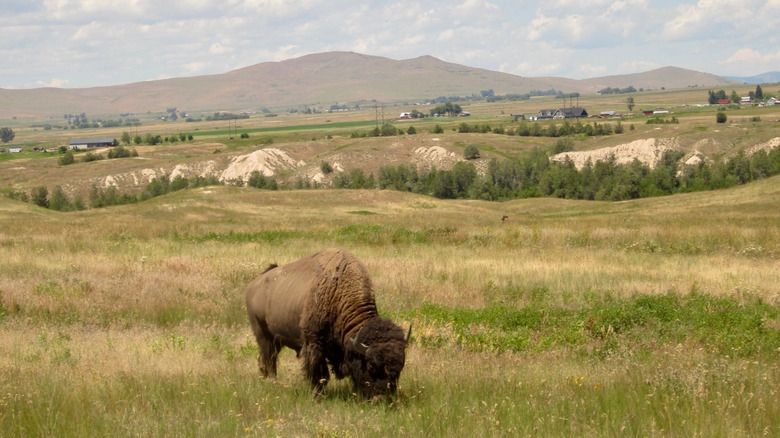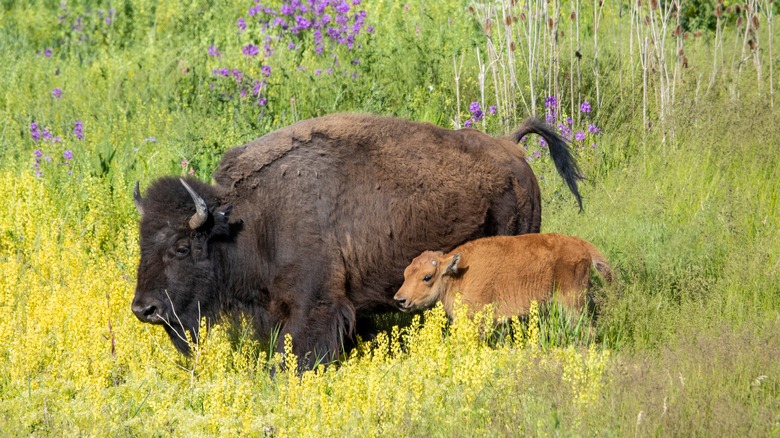Montana's Underrated Refuge Is The Best Destination To See Bison Roam (Other Than Yellowstone)
Just two centuries ago, tens of millions of bison roamed across North America, their herds so massive that their approach sounded like rolling thunder. These enormous ancient beasts lived during the Ice Age, but unlike mammoths and saber-toothed tigers, they have returned from the brink of extinction and are still walking the earth today. Yellowstone National Park is known for providing visitors with the rare opportunity to see a wide variety of wild animals in their national habitat, especially bison. However, it's not the only place in the United States where you can see bison roam today. The very best place for travelers interested in seeing these enormous creatures might be the Confederated Salish and Kootenai Tribes Bison Range.
About three hours east of Spokane, Washington, this remarkable Montana refuge has a long history. Once, this land was designated as protected lands by President Theodore Roosevelt to try to save the dwindling bison population. Then, it was called the National Bison Range and was under the control of the U.S. Fish and Wildlife Service, despite being within Salish and Kootenai lands. In 2020, however, the land was returned to the Confederated Salish and Kootenai Tribes and it is managed by the Flathead Indian Reservation and the CSKT Natural Resource Department.
Yellowstone is estimated to be home to around 5,400 bison, while the Confederated Salish and Kootenai Tribes (CSKT) Bison Range only has about 350. However, Yellowstone is also more than 100 times larger than the CSKT Bison Range, which makes its population a lot more impressive by comparison. The refuge is open between May and October, from 7 a.m. to 8 p.m. There are limited winter hours between November to April, but not all the routes through the land are open. Expect to pay $20 to drive into the bison range
How to explore the CSKT Bison Range for yourself
The only way to visit the range is to drive through. The views through your windshield are spectacular, with rolling grasslands over the hills in every direction, interspersed with little ponderosa pine groves. There are two different routes you can take, the mountainous Red Sleep Drive and the flatter Prairie Drive. The year-round Red Sleep Mountain Drive takes you through a variety of landscapes within the refuge, including grasslands, pine forests, and a high mountain. It also provides the opportunity to see many different kinds of wildlife, too. This is a fantastic place for bird lovers, and for a time in the summer, you're almost guaranteed to see a bear hunting for delicious berries along the creek. You might get to spot elk and deer grazing here, too.
If you combine the two routes through the refuge, you should expect to be diving for about two hours — though when you see bison, chances are that you will pull over and watch them for a while, so you should plan to have some extra time. If you prefer to explore on foot, there are two trails that branch off Red Sleep Drive that you can walk, too — just make sure to stay on the paths or in designated areas that are clearly for humans, like the picnic tables. If you do spot some exciting animals, don't try to take a dangerous selfie with wildlife. In fact, you shouldn't approach them at all. You're specifically required to stay 100 yards away from bears and other predators and 25 yards away from bison and other animals.
How to see bison on the CSKT Bison Range
While there is a risk that you'll miss the bison, your chances of seeing them are very good. There are many, many reviews of the refuge on Google Maps, and only a few of them mentioned not being able to see any bison. If you head to the right place at the right time, however, you can give yourself the best shot possible. Just like in Yellowstone, the best time to look for bison is when they're at their most active — early morning and early evening. You may also want to consider bringing some binoculars, just in case, as one reviewer mentioned, the bison are visible but too far from the road to really see.
Bison can obviously be anywhere in the CSKT Bison Range, and are sometimes right by the road, startlingly close to your vehicle. Sometimes, they will even stand in the road, blocking traffic! They love to graze in the grasslands, so there is a lot of territory that they may be in along the way. Pay particularly close attention to the dry dust beds in clay banks along the Red Sleep Mountain Drive, though. These are favorite places for bison, and you might get to spot them playfully rolling in the dirt, sending big clouds up all around them.


